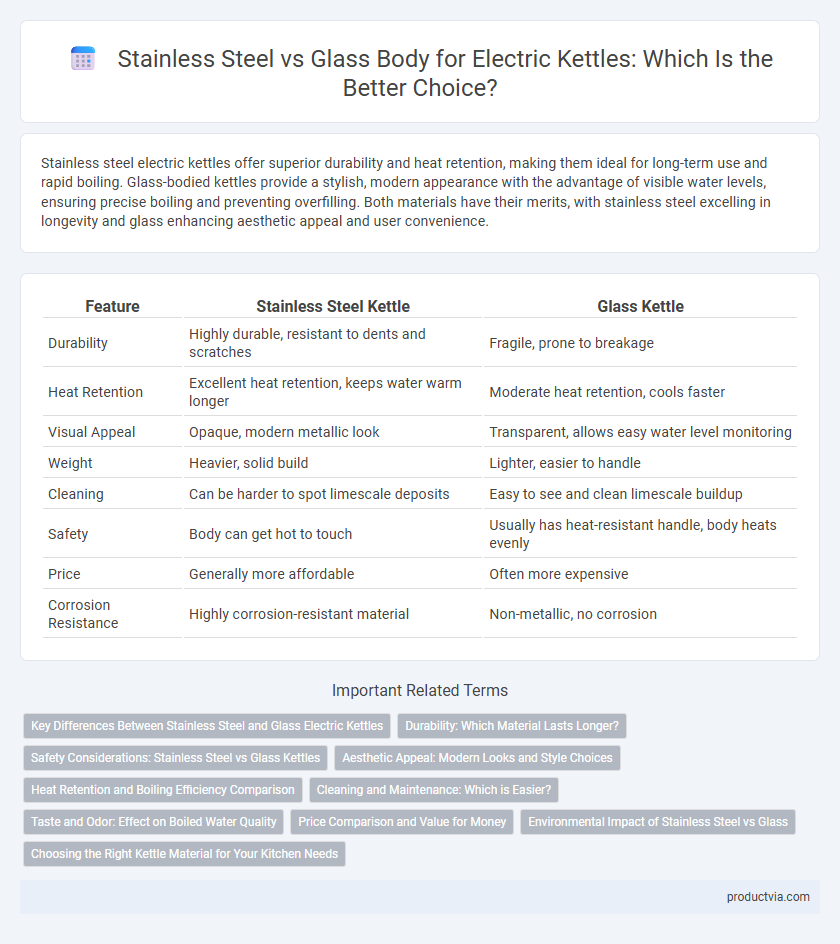Stainless steel electric kettles offer superior durability and heat retention, making them ideal for long-term use and rapid boiling. Glass-bodied kettles provide a stylish, modern appearance with the advantage of visible water levels, ensuring precise boiling and preventing overfilling. Both materials have their merits, with stainless steel excelling in longevity and glass enhancing aesthetic appeal and user convenience.
Table of Comparison
| Feature | Stainless Steel Kettle | Glass Kettle |
|---|---|---|
| Durability | Highly durable, resistant to dents and scratches | Fragile, prone to breakage |
| Heat Retention | Excellent heat retention, keeps water warm longer | Moderate heat retention, cools faster |
| Visual Appeal | Opaque, modern metallic look | Transparent, allows easy water level monitoring |
| Weight | Heavier, solid build | Lighter, easier to handle |
| Cleaning | Can be harder to spot limescale deposits | Easy to see and clean limescale buildup |
| Safety | Body can get hot to touch | Usually has heat-resistant handle, body heats evenly |
| Price | Generally more affordable | Often more expensive |
| Corrosion Resistance | Highly corrosion-resistant material | Non-metallic, no corrosion |
Key Differences Between Stainless Steel and Glass Electric Kettles
Stainless steel electric kettles offer superior durability, heat retention, and resistance to breakage compared to glass models, making them ideal for long-term use. Glass kettles provide visual clarity for water level monitoring and aesthetic appeal but are more fragile and prone to showing water stains or mineral build-up. The choice between stainless steel and glass bodies impacts factors like heat conduction, maintenance, and overall lifespan of the electric kettle.
Durability: Which Material Lasts Longer?
Stainless steel electric kettles offer superior durability due to their resistance to dents, scratches, and corrosion, making them ideal for long-term use. Glass kettle bodies, while visually appealing, are more prone to breakage and require careful handling to avoid cracks or shattering. Overall, stainless steel kettles typically last longer, providing a robust and maintenance-friendly option for everyday boiling needs.
Safety Considerations: Stainless Steel vs Glass Kettles
Stainless steel electric kettles offer superior durability and resistance to breakage, reducing the risk of injuries from shattered glass. Glass kettles allow users to easily monitor water levels and boiling progress, but they are more prone to cracks and require careful handling to prevent burns from hot surfaces. Both materials must meet safety standards for heat resistance and food-grade quality to ensure user protection.
Aesthetic Appeal: Modern Looks and Style Choices
Stainless steel electric kettles offer a sleek, modern look with a polished finish that complements contemporary kitchen designs and provides durability against scratches and stains. Glass-bodied kettles deliver a transparent, elegant aesthetic allowing users to monitor water levels and boiling progress visually, adding a stylish, minimalist touch to any countertop. Choosing between stainless steel and glass depends on personal style preferences and the desired blend of functionality and visual appeal in kitchen appliances.
Heat Retention and Boiling Efficiency Comparison
Stainless steel electric kettles offer superior heat retention due to their insulated metal body, which minimizes heat loss and maintains water temperature longer than glass models. Glass kettles, while visually appealing, typically exhibit lower boiling efficiency because their transparent walls allow more heat to escape, resulting in longer boiling times and increased energy consumption. Choosing a stainless steel body enhances overall energy efficiency and preserves heat, making it ideal for rapid boiling and prolonged temperature maintenance.
Cleaning and Maintenance: Which is Easier?
Stainless steel electric kettles offer superior ease of cleaning due to their non-porous surface, resisting stains and odors more effectively than glass. Glass kettles require more frequent cleaning to prevent mineral buildup and water stains, especially in hard water areas. Maintenance is simpler with stainless steel models as they typically need less frequent descaling and show fewer signs of wear over time.
Taste and Odor: Effect on Boiled Water Quality
Stainless steel electric kettles typically do not alter the taste or odor of boiled water, maintaining a neutral flavor due to their non-porous surface. Glass kettles offer a pure boiling experience with no metallic taste and allow users to see the water level clearly, enhancing perceived water quality. Both materials avoid chemicals leaching into water, but glass is often preferred for preserving the natural taste and odor of boiled water.
Price Comparison and Value for Money
Stainless steel electric kettles typically offer greater durability and often come at a lower price point compared to glass models, making them a cost-effective choice for long-term use. Glass electric kettles, while usually priced higher, provide better visibility of water levels and can enhance the aesthetic appeal of a kitchen. Evaluating value for money depends on balancing budget considerations with preferences for design and durability in electric kettle selection.
Environmental Impact of Stainless Steel vs Glass
Stainless steel electric kettles generally have a lower environmental impact due to their durability and recyclability, reducing the need for frequent replacements and minimizing landfill waste. Glass kettles, while visually appealing and made from non-toxic materials, often involve higher energy consumption during manufacturing and are more prone to breakage, leading to increased environmental burden over time. Choosing stainless steel supports sustainable consumption through extended product lifespan and efficient recycling processes.
Choosing the Right Kettle Material for Your Kitchen Needs
Stainless steel electric kettles offer durability, heat retention, and resistance to rust, making them ideal for heavy use and longevity in busy kitchens. Glass body kettles provide visual appeal and allow users to monitor water levels easily, promoting convenience and aesthetic value. Choosing between stainless steel and glass depends on your priorities for robustness, heat insulation, and kitchen design integration.
Stainless steel vs glass body for electric kettle Infographic

 productvia.com
productvia.com